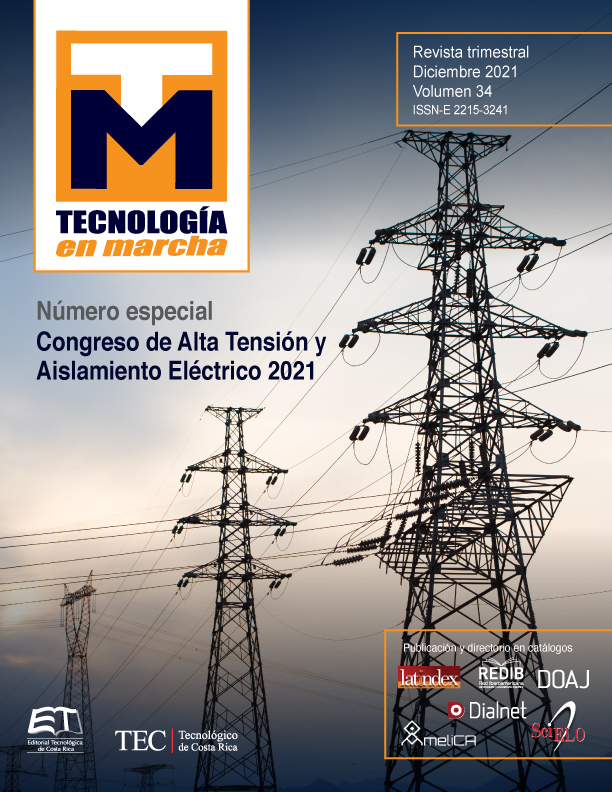SAP for modeling the deformation of aerial cables in high voltage substations
Main Article Content
Abstract
The installation of cables for connection between electrical substation equipment are designed considering loads due to short circuit, own weight, wind, among others, however, they omit additional conditions depending on the final installation or exclude loads, such as those present in high-rise areas. seismic activity, aspects that would complement the cable deformation calculation, on the other hand, the design effort is usually disconnected in 3D models, since they only use anchor points and “splines” to define their trajectory. Knowing the approximate deformation of the cable is important for verifying electrical safety distances, minimizing possible inconveniences in the construction phase. This document presents the integration of various load models for cables, in a finite element representation with SAP2000, including final installation conditions and seismic loads according to IEEE 1527, guaranteeing connection stability, electrical safety distances and equipment integrity. Additionally, the deformation results are connected with an application developed in Dynamo-Python to complement the BIM model in Revit. The methodology is validated according to connection cases documented by the Pacific Earthquake Engineering Research Center (PEER), which records deformation measurements for cables used in electrical substations under different load and installation scenarios. With the proposed integration, expected deformations are obtained at low displacements, presenting a better trajectory adjustment and stress calculation according to those reported by PEER, however, for high displacements, representative differences are obtained in the measured efforts, an aspect to be improved.
Article Details

This work is licensed under a Creative Commons Attribution-NonCommercial-NoDerivatives 4.0 International License.
Los autores conservan los derechos de autor y ceden a la revista el derecho de la primera publicación y pueda editarlo, reproducirlo, distribuirlo, exhibirlo y comunicarlo en el país y en el extranjero mediante medios impresos y electrónicos. Asimismo, asumen el compromiso sobre cualquier litigio o reclamación relacionada con derechos de propiedad intelectual, exonerando de responsabilidad a la Editorial Tecnológica de Costa Rica. Además, se establece que los autores pueden realizar otros acuerdos contractuales independientes y adicionales para la distribución no exclusiva de la versión del artículo publicado en esta revista (p. ej., incluirlo en un repositorio institucional o publicarlo en un libro) siempre que indiquen claramente que el trabajo se publicó por primera vez en esta revista.
References
IEEE “Recommended Practice for the Design of Buswork Located in Seismically Active Areas”, in IEEE Std 1527-2018 (Revision of IEEE Std 1527-2006), pp.1-91, 10 Aug. 2018, doi: 10.1109/IEEESTD.2018.8439125.
IEEE Approved Draft “Recommended Practice for Seismic Design of Substations”, in IEEE P693/D18, July 2018, pp.1-231, 23 Oct. 2018.
J. B. Dastous, A. D. Kiureghian, “Application Guide for the Design of Flexible and Rigid Bus Connections between Substations Equipment Subjected to Earthquakes”, Pacific Earthquake Engineering Research Center, Sept 2010.
Norma Española UNE-EN 60865-1, “Corrientes de cortocircuito – Cálculo de efectos - , Parte 1: Definiciones y métodos de cálculo”, Asociación Española de Normalización Génova, Oct 2018.
American Society of Civil Engineers, “Guidelines for Electrical Transmission Line Structural Loading, Task Committee on Electrical Transmission Line Structural Loading”, American Society of Civil Engineers Fourth Edition , 2020, doi https://doi.org/10.1061/9780784415566.
American Society of Civil Engineers, “Substation Structure Design Guide: ASCE Manuals and Reports on Engineering Practice No. 113”, American Society of Civil Engineers, 2008.
Computers and Structures Inc, “Integrated Finite Element Analysis and Design of Structures”, Computers and Structures Inc SAP 2000 – Advanced v20.2.1., 2019.
G. Talarico, Comunidad Dynamo, Revit API docs. Accedido: Jun. 29, 2021 [Online], Disponible: https://www. revitapidocs.com/.
L. Johnson, Comunidad Dynamo, Dynamo Nodes. Accedido: Jun. 29, 2021 [Online], Disponible: https://dynamonodes.com/.
O. Green, Comunidad Dynamo, Dynamo Python, Accedido: Jun. 29, 2021 [Online], Disponible: https://dynamopythonprimer.gitbook.io/dynamo

